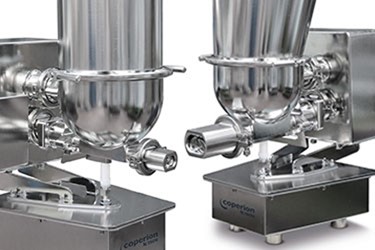Pharmaceutical Manufacturing Feeding Technology

With over 100 years of experience in feeding technology, Coperion K-Tron development and engineering teams have created smart feeding solutions. Without consistent, dependable feeder accuracy and repeatability for your process, the integrity of any recipe—and hence the final product—will be compromised.
Material Challenges
Our customers are a diverse group of global industries. They range from producers of bulk and fine chemicals, to petrochemicals, food and beverages, pharmaceuticals and nutraceuticals, polymers and plastics, pulp and paper, paints and pigments, soaps and detergents, fertilizers and agricultural chemicals. While these industrial segments differ vastly, they all use feeders to control the flow of bulk material that is to be converted into finished products.
The behavior of dry bulk solids (such as powders, pellets, flakes, granules and fibers) varies with each material’s chemical and physical characteristics and flow properties. Key characteristics include the size and shape of the particle, the material’s bulk density, compressibility, cohesive strength, moisture, oil or fat content, and the way in which the material behaves under atmospheric and loading conditions (for example, its potential for compaction or water absorption).
Process equipment manufacturers have developed a vast body of expertise and a wide range of feeding technology options to address the multitude of challenges that can arise for process operations involving bulk solids. Your feeder selection–and the success of your application–will be greatly influenced by the specific characteristics of the materials you must feed, the recipe precision needed for your process and the throughput required.
The flow behavior of different bulk solids can vary greatly depending on the material properties or particle geometry. No single feeder design or feeder size can handle all the different material characteristics or throughput requirements. The following short list describes the behaviors most commonly encountered in the pharmaceutical industry and the feeding solutions that feeder equipment manufacturers such as Coperion K-Tron have developed to handle these bulk solids challenges.
Easy-flowing materials, such as some granulations or blends are most frequently metered with a single screw feeder. A variety of screw sizes and geometries are available to accommodate different material characteristics and desired feedrates.
Floodable materials, including very fine and micronized materials can behave like liquids if not properly controlled during hopper discharge and feeding. Here a feeder with interlocking twin screws is often the best choice. The intermeshing screw flights act as a valve to control material flow.
Difficult-flowing materials, such as magnesium stearat, micronized lactose, crosscarmellose sodium, povidone, carnauba wax, and sucrose often require special feeder designs and other flow-aid devices to enable better control of discharge during feeding. There are many different metering options, with screw feeders and vibratory feeders being the most frequent choices.
Cohesive materials, such as silicone dioxide and a wide variety of APIs create additional challenges during process operations, and are particularly susceptible to bridging inside hoppers and cake or accrete to the equipment surfaces. These materials are often best handled by a twin screw feeder with hopper agitation, such as Coperion K-Tron’s ActiFlowTM.
Fragile and friable materials, such as finished or uncoated tablets or sensitive granulations can be handled gently and accurately via vibratory loss-in-weight feeders.
Without consistent, dependable feeder accuracy and repeatability for your process, the integrity of any recipe—and hence the final product—will be compromised. This will directly impact the system reliability, product yield and economic performance of the overall operation.
